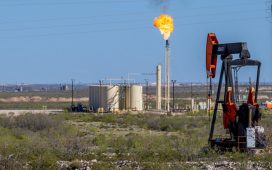Topline
Reflecting ongoing optimism over the economic recovery, the Organization of the Petroleum Exporting Countries (OPEC) and a group of Russia-led oil producers agreed Tuesday to increase oil output by 450,000 barrels per day beginning next month, the Wall Street Journal reported, a modest uptick meant to temper higher oil demand as businesses continue to reopen and travel picks back up worldwide.

Oil pumping jacks, also known as “nodding donkeys”, operate in an oilfield near Neftekamsk, Russia.
© 2020 Bloomberg Finance LP
Key Facts
The output boost means producers will supply about 4 million more oil barrels per day than at the height of pandemic uncertainty in early 2020—still far lower than the 9.7 million additional barrels they were producing before the pandemic tanked oil demand, according to WSJ.
The agreement by OPEC+, a group of producers led by Saudi Arabia and Russia, was largely expected after the group said in April it would raise output by more than 2 million barrels per day by July, and it marks a stark reversal from a bitter disagreement at the end of last year as members struggled to come to terms on expected oil demand.
The price of U.S. oil benchmark West Texas Intermediate was up 3% Tuesday after the announcement, while the price of the United Kingdom’s Brent Crude ticked up 2%.
The uptick should help curb rising oil prices, which have climbed back to pre-pandemic levels, while producers assess the risk of rapidly spreading variants in countries like India once again tanking demand and shuttering economies, Morgan Stanley analysts said in a Tuesday note.
Key Background
Despite easing lockdowns and an accelerating vaccine rollout, producers have been careful to ramp up supply after excess inventories drove prices down to negative territory for the first time in history last spring. That happened after an all-out price war erupted between oil-producing giants Russia and Saudi Arabia last March, just as demand began to plummet during the coronavirus outbreak. Costly-to-maintain storage tanks then filled up with no buyers, and the price of one American oil futures contract plunged below zero in April 2020. OPEC and its allies agreed to cut production in order to stabilize prices amid the turmoil, but according to the International Energy Agency, those inventories are still being worked off to this day.
Big Number
40%. That’s how much the prices of WTI and Brent crude oil have each climbed this year. Despite the stark plunge last spring, prices recouped all their pandemic losses by March.
Tangent
Friday marked the busiest day for U.S. air travel since last March, according to the Transportation Security Administration, and nearly 63% of Americans have now received at least one Covid-19 vaccine.








